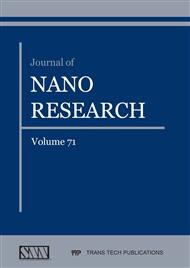[1]
J. Hu, C. Sun, X. Jiang, Z. Zhang, L. Shu, Flashover Performance of Pre-contaminated and Ice-covered Composite Insulators to be Used in 1000 kV UHV AC Transmission Lines, IEEE Trans. Dielectr. Electr. Insul., 14 (2007) 1347-1356.
DOI: 10.1109/tdei.2007.4401217
Google Scholar
[2]
X. Liang, S. Li, Y. Gao, Z. Su, J. Zhou, Improving the outdoor insulation performance of Chinese EHV and UHV AC and DC overhead transmission lines, IEEE Electr. Insul. Mag. 36 (2020) 7-25.
DOI: 10.1109/mei.2020.9111096
Google Scholar
[3]
G. Heger, H.J. Vermeulen, J.P. Holtzhausen, W.L. Vosloo, A Comparative Study of Insulator Materials Exposed to High Voltage AC and DC Surface Discharges, IEEE Trans. Dielectr. Electr. Insul. 17 (2010) 513-520.
DOI: 10.1109/tdei.2010.5448107
Google Scholar
[4]
S.F. Kaaiye, C. Nyamupangedengu, Comparative study of AC and DC inclined plane tests on silicone rubber (SiR) insulation, IET High Volt. 2 (2017) 119-128.
DOI: 10.1049/hve.2016.0102
Google Scholar
[5]
E. Moal, J. Seifert, and K. Radlinger, Comparison of Laboratory Test, Field Station and Service Performance of HTV and LSR Hollow Core Housings, Int. Symp. on High-Voltage Engineering (ISH), Budapest, Hungary (2019) 459-471.
DOI: 10.1007/978-3-030-31680-8_47
Google Scholar
[6]
A.R. Verma and R.B. Subba, Understanding Surface Degradation on Polymeric Insulators Using Rotating Wheel and Dip Test under DC Stress, IEEE Trans. Dielectr. Electr. Insul., 25 (2018) 2029-2037.
DOI: 10.1109/tdei.2017.007119
Google Scholar
[7]
A.R. Verma and R.B. Subba, Tracking and Erosion Resistance of LSR and HTV Silicone Rubber Samples under Acid Rain Conditions, IEEE Trans. Dielectr. Electr. Insul. 25 (2018) 46-52.
DOI: 10.1109/tdei.2018.006672
Google Scholar
[8]
G.P. Bruce and S.M. Rowland, Performance of Silicone Rubber in DC Inclined Plane Tracking Tests, IEEE Trans. Dielectr. Electr. Insul. 17 (2010) 521-532.
DOI: 10.1109/tdei.2010.5448108
Google Scholar
[9]
R.A. Ghunem, S.H. Jayaram and E.A. Cherney, Erosion of Silicone Rubber Composites in the AC and DC Inclined Plane Tests, IEEE Trans. Dielectr. Electr. Insul. 20 (2013) 229-236.
DOI: 10.1109/tdei.2013.6451362
Google Scholar
[10]
J.V. Vas, B. Venkatesulu and M.J. Thomas, Tracking and Erosion of Silicone Rubber Nanocomposites under DC Voltages of both Polarities, IEEE Trans. Dielectr. Electr. Insul. 19 (2012) 91-98.
DOI: 10.1109/tdei.2012.6148506
Google Scholar
[11]
M.S.H. Al‑Furjan, M. Habibi, J. Ni, D.W. Jung, A. Tounsi, Frequency simulation of viscoelastic multi‑phase reinforced fully symmetric systems, Engineering with Computers (2020).
DOI: 10.1007/s00366-020-01200-x
Google Scholar
[12]
M.S.H. Al-Furjan, M. Habibi, D.W. Jung, S. Sadeghi, H. Safarpour, A. Tounsi, G. Chen, A computational framework for propagated waves in a sandwich doubly curved nanocomposite panel, Engineering with Computers (2020).
DOI: 10.1007/s00366-020-01130-8
Google Scholar
[13]
M.S.H. Al-Furjan, A. Hatami, M. Habibi, L. Shan, A. Tounsi, On the vibrations of the imperfect sandwich higher-order disk with a lactic core using generalize differential quadrature method, Composite Structures, accepted October 2020 (article in press).
DOI: 10.1016/j.compstruct.2020.113150
Google Scholar
[14]
A. Draoui, M. Zidour, A Tounsi, B. Adim, Static and Dynamic Behavior of Nanotubes-Reinforced Sandwich Plates Using (FSDT), Journal of Nano Research 57 (2019) 117–135.
DOI: 10.4028/www.scientific.net/jnanor.57.117
Google Scholar
[15]
IEC 60587, Electrical insulating materials used under severe ambient conditions – Test methods for evaluating resistance to tracking and erosion (2007).
DOI: 10.3403/30366448
Google Scholar
[16]
ASTM D2303, Standard test method for liquid-contaminant, inclined plane tracking and erosion of insulating materials (2004).
DOI: 10.1520/d2303-13
Google Scholar
[17]
K.O. Papailiou and F. Schmuck, Silicone composite insulators: materials, design, applications, first ed., Springer-Verlag, Berlin, (2013).
Google Scholar
[18]
Instruction manual for 202A Power Supply, Document: 83493001 Rev. P, TDK-Lambda Americas.
Google Scholar
[19]
E. A. Cherney, Silicone rubber dielectrics modified by inorganic fillers for outdoor high voltage insulation applications, IEEE Transactions on Dielectrics and Electrical Insulation 12 (2005), 1108-1115.
DOI: 10.1109/tdei.2005.1561790
Google Scholar
[20]
L.E. Nielsen, The electrical and thermal conductivity of two-phase systems, Monsanto Research Corporation, St. Louis Missouri (1972).
Google Scholar
[21]
R.A. Ghunem, D. Koné, L. Cissé, Y. Hadjadj, H. Parks, D. Ambroise, Effect of Hydrated Fillers in Silicone Rubber Composites during AC and DC Dry-Band Arcing, IEEE Trans. Dielectr. Electr. Insul. 27 (2020) 249-256.
DOI: 10.1109/tdei.2019.008411
Google Scholar
[22]
D. Chen, J. Nie, S. Yi, W. Wu, Y. Zhong, J. Liao, C. Huang, Thermal behaviour and mechanical properties of novel RTV silicone rubbers using divinyl-hexa[(thrimetoxisilyl(ethyl)]-POSS as crosslinker, Polym. Degrad. Stab. 95 (2010) 618-626.
DOI: 10.1016/j.polymdegradstab.2009.12.002
Google Scholar
[23]
I. S. Isayeva and J. P. Kennedy, Amphiphilic Membranes Crosslinked and Reinforced by POSS, J. Polym. Sci. Part A: Polym. Chem. 42 (2004) 4337-4352.
DOI: 10.1002/pola.20262
Google Scholar
[24]
I. Ramirez-Vázquez, R. Nava, Application of nano particles for the modification of high voltage insulators, IEEE Trans. Dielectr. Electr. Insul. 20 (2013) 2262-2269.
DOI: 10.1109/tdei.2013.6678878
Google Scholar
[25]
N. Burger, A. Laachachi, M. Ferriol, M. Lutzc, V. Toniazzo, and D. Rucha, Review of thermal conductivity in composites: Mechanisms, parameters and theory, Progress in Polymer Science 61 (2016) 1-28.
DOI: 10.1016/j.progpolymsci.2016.05.001
Google Scholar


